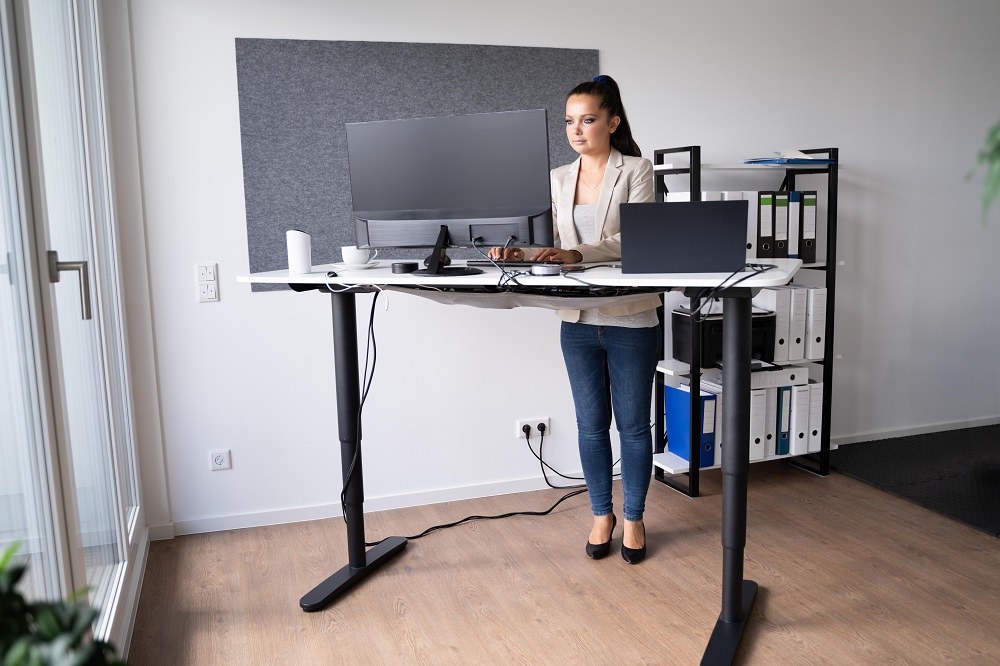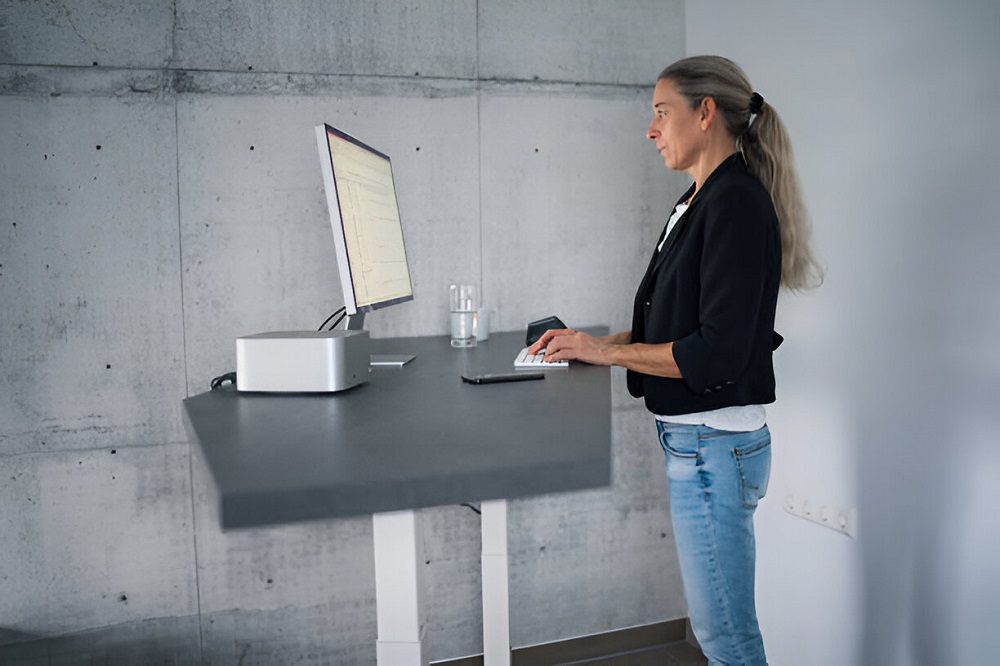Have you ever wondered if there's a simple way to boost productivity, improve employee health, and cut healthcare costs simultaneously?
Imagine a workplace innovation that transforms the office environment and enhances the well-being of your team members.
What if this solution was as straightforward as changing how your employees work?
Importance of Standing Desks in Offices
In recent years, the corporate world has begun to recognize the significance of promoting employee health and well-being within the workplace.
Traditional office setups, characterized by prolonged sitting periods, have been linked to numerous health issues, prompting organizations to explore alternative solutions. One such solution gaining widespread popularity is the implementation of standing desks.
Standing desks offer a dynamic approach to the conventional office environment, encouraging employees to alternate between sitting and standing throughout the workday.
This shift not only addresses the health concerns associated with sedentary behavior but also fosters a culture of wellness and productivity.
Long-Term Health Benefits
Ergonomic standing desks offer many benefits in modern workspaces.
Let’s examine the long-term health benefits of incorporating ergonomic standing desks in workstations.
Reduced Risk of Obesity
Sedentary lifestyles, often dictated by prolonged sitting at work, are major contributors to the rising obesity rates worldwide. Standing desks provide a practical way to counteract this trend.
Standing desks allow employees to stand and move more frequently, increasing caloric expenditure and reducing the risk of weight gain and obesity.
Over time, this increased activity can lead to significant health improvements and a lower risk of obesity.
Lowered Risk of Chronic Diseases
Prolonged sitting has been linked to an increased risk of various chronic diseases, including cardiovascular disease, type 2 diabetes, and certain cancers.
Standing desks promote a more active lifestyle, which can help mitigate these risks. Regular movement and standing intervals throughout the day improve blood circulation, reduce blood sugar levels, and enhance insulin sensitivity.
Improved Posture and Reduced Back Pain
One of the most common complaints among office workers is back and neck pain, often resulting from poor posture and extended periods of sitting.
Standing desks encourage better posture by allowing employees to adjust their workstations to an ergonomic height, reducing strain on the spine and neck.
Alternating between sitting and standing also helps to alleviate pressure on the lower back, reducing the risk of musculoskeletal issues.
Productivity and Performance

Ergonomic Standing Desks offer multiple performance benefits among employees, such as:
Enhanced Focus
Maintaining focus and concentration during long work hours can be challenging, especially when confined to a seated position. The act of standing stimulates blood flow and oxygen delivery to the brain, promoting mental alertness and clarity.
Increased Energy Levels
A common complaint among office workers is midday fatigue, often resulting from prolonged sitting and a lack of physical activity. Standing desks combat this issue by promoting movement and reducing the tendency to become sedentary.
Reduced Workplace Fatigue
Workplace fatigue can significantly impact employee morale and performance. Standing desks help to mitigate fatigue by encouraging periodic movement and reducing the physical strain associated with prolonged sitting.
Employee Well-being and Morale
Increased Job Satisfaction
Employee well-being is closely linked to job satisfaction, and standing desks promote both. By providing employees with the option to stand and move during work hours, organizations demonstrate a commitment to their health and comfort.
Reduced Stress Levels
The work pressure at modern workplaces can be a source of significant stress, contributing to burnout that hampers day-to-day productivity.
Standing desks offer a practical solution to stress levels by promoting physical activity and reducing the discomfort associated with prolonged sitting.
Positive Impact on Mental Health
Mental health is critical to well-being, and standing desks can positively impact this. Physical activity and movement release endorphins, which are natural mood enhancers.
By incorporating standing desks into the workplace, employees can benefit from these mood-boosting effects, leading to improved mental health and a more positive outlook.
Additionally, these desks reduce physical discomfort & pain and improve mental well-being.
Employee Engagement and Retention
Employee engagement is key to organizational success, and standing desks can enhance engagement levels. Employees who feel that their health and well-being are prioritized are more likely to be committed and engaged in their work.
Economic Benefits for Companies
Implementing standing desks promotes employee health and yields substantial economic benefits for companies.
Let’s see what benefits does incorporating an ergonomic standing desk offers for companies.
Reduced Healthcare Costs
The long-term health benefits of standing desks lead to reduced healthcare costs for organizations. By promoting a healthier and more active workforce, companies can decrease chronic diseases and musculoskeletal issues, lowering medical expenses.
Decreased Absenteeism
Employee absenteeism can be costly for organizations, disrupting workflow and decreasing productivity. Standing desks reduce absenteeism by promoting better health and well-being among employees.
Healthier employees are less likely to take sick days or require extended leave due to health-related issues.
Improved Productivity for Higher Profits
The combined benefits of increased productivity, reduced fatigue, and higher job satisfaction ultimately improve organizations' profitability.
- Create an environment that fosters optimal performance and well-being.
- Enabling employees to work more efficiently and effectively.
- An increase in productivity translates to higher output and, consequently, higher profits.
By investing in standing desks, companies can achieve a substantial return on investment through improved performance and financial gains.
Implementation Strategies
Successful implementation of standing desks requires a strategic approach. Organizations should gradually introduce standing desks to allow employees to adapt to the change. Providing education and training on the benefits and proper use of standing desks is essential to ensure their effective utilization.
Conclusion
The long-term benefits of implementing ergonomic standing desks in corporate offices are substantial and far-reaching. From improved health outcomes and increased productivity to enhanced employee well-being and economic gains, standing desks offer a holistic approach to workplace wellness.
Organizations can create a more engaged, motivated, and productive workforce by prioritizing employees' health and comfort. As the corporate world evolves, adopting standing desks represents a progressive step towards a healthier and more prosperous future.




